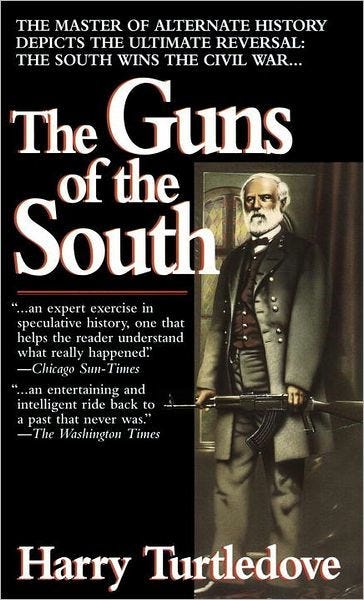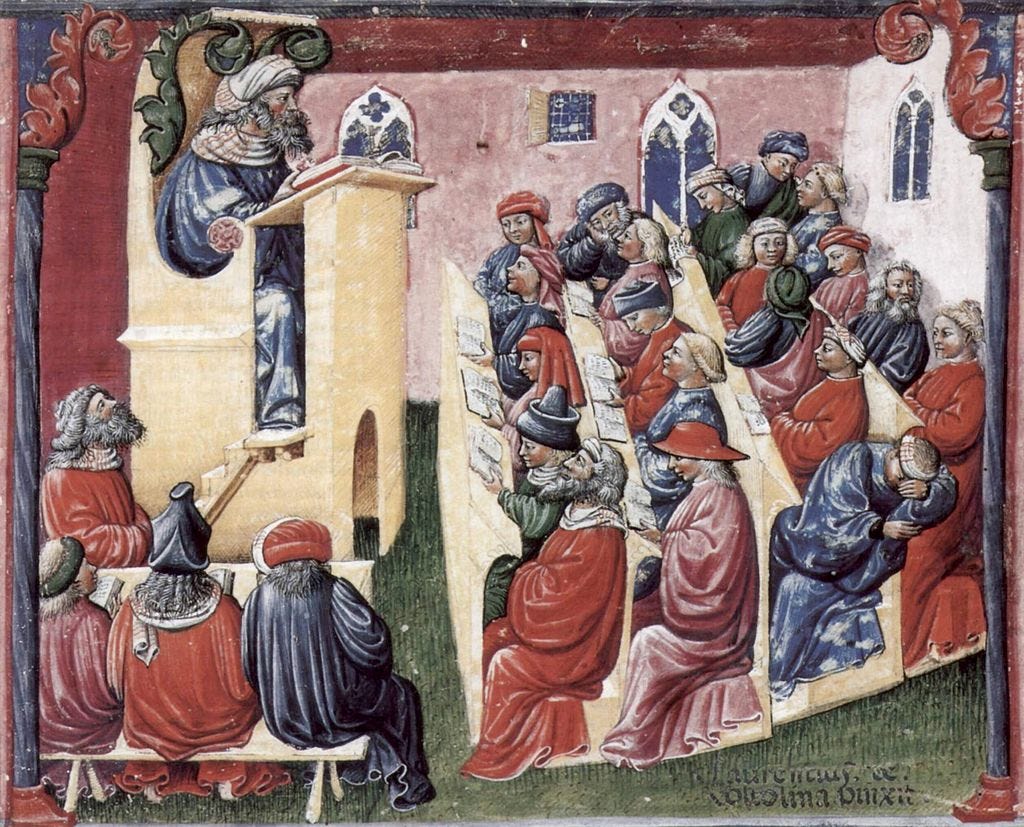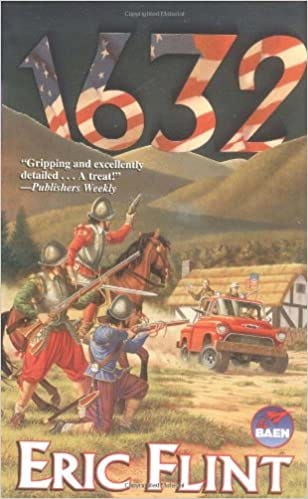Steampunk Byzantines, Americans during the Thirty Years War, and Alternate History
Thoughts on what we can learn from Alternate History, and why the 6th century was so pivotal.
Over the weekend, a reader tagged me in a twitter thread on what you could do if you took a smartphone back into the past (shout out to Nikola Ivanov for the mention). The topic was fun to kick around, and so I thought it’d be worth writing up.

The original thread then listed a few different categories (mapping, YouTube videos, computational power and records, weather, etc.) where a time traveler with an iPhone might have a major advantage over historical individuals. I wrote up some specific thoughts on where I thought a smartphone might be the most helpful (or where it might be surprisingly limited), but the topic got me thinking about the field of alternate history.
Aside from simply being amusing, and a good reminder of how remarkably powerful our personal supercomputers are, I think these sorts of thought experiments, rather than superficial or silly (well, sometimes), can actually be very useful for historical interpretation. While not a pure counterfactual such as “what would’ve happened if Hitler hadn’t declared war on America,” going back in time with modern knowledge and following the dominos as they fall can test how well we understand a given society, and tell us more about how the modern world arose. This should especially be done more often when thinking about the history of innovation.
I can think of a couple book series that deal with this sort of topic in more detail and depth, though not specifically from the perspective of “what could I do with a modern smartphone in the past?” I should offer the disclaimer that I’m not especially well-read in “alternate history” as a genre, though I do know Harry Turtledove’s novels get a lot of attention here. As far as I can tell too much of the genre is obsessed with “what if '' scenarios involving either the Civil War WW II. The main thing I recall hearing about some of Turtledove’s books is someone in the present giving automatic weapons to the Confederacy, causing the Union to lose the Civil War, and creating two American nations into the mid-20th century.

I can comment on at least a pair of alternate history titles; the “1632” novels by Eric Flint and many co-authors, as well as the “Belisarius Saga” by Eric Flint and David Drake. These novels and their authors come from the non-mainstream publishing world adjacent to sci-fi and fantasy, and they have delightfully cheesy cover artwork. The premises of both series are rather ridiculous; in 1632, a space-time continuum accident caused by cosmic interstellar beings transports a small West Virginian coal mining town from around the year 2000 AD into the middle of 17th century Germany during the Thirty Years War. In the Belisarius books, a conflict between humanity’s descendants millions of years in the future leads to an attempt to permanently alter the human timeline by sending emissaries back to 6th century India and Byzantium, introducing knowledge of subsequent history and technology.
Obviously, both premises are faintly ridiculous. 1632 spends about a paragraph explaining the cosmic accident, and then deliberately never returns to it. Time travel is mostly just a vehicle to answer important questions such as “what would modern firearms do to 17th century pike and shot formations?” And, “could you have made katyusha rocket-style chariots?” As someone who has daydreamed about the minimum number of modern weapons needed to save Constantinople from Mehmed II in 1453, I clearly think these questions need no justification.
But actually, you pretty quickly find in both series that simple tactical questions such as “could you turn a coal mining truck into an armored personnel carrier?” pale in the face of all the second and third-order social, technological, economic, and political knock-on effects. And it’s here that I think both series of novels are most useful. Both are written by amateur historians who clearly love their subject matter, and possess the ability to get “inside” other historical cultures. While not great literature (and not particularly subtle), both series possess memorable characters, and don’t shy away from the ugly brutality of history, while also telling stories of real heroism.
Starting the American Revolution a hundred and fifty years early -
In the novel 1632, the “uptimers” from Grantville, West Virginia quickly realize that they can’t reproduce late 20th century technology, and so they deliberately gear down to a 19th century industrial base. They can’t build cars, phones, and lay down asphalt roads, but steam power, rail lines, and simple radios, batteries, and electric dynamos are all reasonably feasible.
Along the way, you realize just how much knowledge and skills even a small rural American town 20 years ago had. The local high school contains a library sufficient to massively advance European science, engineering, and medicine by several centuries, a town of three-thousand coal miners will have enough deer hunters to rout any army in Europe, and the machine tools to create rifled cannons. The book is also a love letter to small-town American associational life, as the townsfolk show enough self-reliance and organizational know-how to make Tocqueville shed a tear, with only reasonable amounts of happy coincidences on the part of the story-telling. In an interesting note touching on our current political realignment, the principal author of the series, Eric Flint, is an old-school union-activist and labor Democrat, yet the books’ celebration of the American Revolution, and of small town blue-collar America, clearly has more in common with today’s American right (though much more nuanced and understated in its self-confidence).
Within a few years of arriving in early-modern Germany, the town of Grantville has heavily influenced the nearby German principalities. The “uptimers'' ultimately make an alliance with Gustavus Adolphus of Sweden, equipping him with machine-tooled cannons, rifled muskets, and financing him with Jewish money drawn to Grantville by virtue of the Americans being massively less anti-semetic than anyone else in Europe (Gustavus is staggered by the offer of a 5% loan). As they create a zone of stability in the midst of one of the most cataclysmically destructive wars of pre-modern Europe, they recruit talent from all over Europe, and turn refugees fleeing violence into the population base for a nascent industrial economy.
A critic could find plenty to nitpick about just how easily feasible all this is, but as a thought experiment, the book is a good look at how the rise of the commercial middle class and industrial capitalism (in a good way) went hand-in-hand with modern democratic self-government. As society shifted away from land and agriculture, the older noble classes who dominated politics and war found their legitimacy and power melt under their feet. When you have an urban population that can produce lots of wealth, pays taxes, and can win wars without you, you can either give them the vote upfront and save yourself time and earn goodwill, or you can try to hold out, and have them take it from you with torches and pitchforks.
In 1632, this social and economic change is streamlined by the conscious addition of the spirit of the American Revolution, and the principles behind the American Bill of Rights. Today, the American Revolution has so successfully influenced the world, pushing it in “our” direction, that it can be easy to forget how remarkable it was in the first place. There’s a (mostly) healthy balance of large material and institutional forces in the book, combined with the particular cultural ideals and philosophical principles of the spirit of 1776, though there’s also an awareness of an old order being washed away.

It’s interesting to realize that the number of American communities that could, on their own, reproduce steam engines and set up a 19th century electrical grid is probably much smaller today than it was just 20 years ago, with our small town communities increasingly hollowed out, and yet ever more reliant on technology requiring semiconductors. Even in the book, the West Virginians face some worth-mentioning limitations, such as the fact that modern industry requires a lot of stainless steel alloy, and that getting petroleum in the middle of early modern-Europe is quite difficult (same for rubber). Finally, most of the “uptimers” are horrified to find out that it’ll be a while before they can import coffee from the Ottoman empire.
Steampunk Byzantium -
The Belisarius Saga by Eric Flint and David Drake is less socio-political than 1632, but reveals even more about what sort of technology and knowledge might have been feasible in the past. The series is an unabashedly larger-than-life treatment of one of history's most criminally underrated generals, and features a memorable cast of supporting characters, including Belisarius’ own wife Antonina (who did actually go on campaign with her husband, although the novels handwave away the rumors of her infidelity as malicious gossip by Procopius, and turn her into a heroic figure in her own right). Justinian and Theodora have entertaining roles, and the empires of the Sassanid Persia and the Ethiopian Axumite empire (which was Monophysite Christian, and did have an alliance with the Byzantine empire) both feature prominently

Belisarius opposes a monstrous Malwa dynasty in Egypt (in reality, the Malwa were a smaller kingdom that emerged from the dissolution of the larger Gupta empire in the early 6th century), which has been tasked with enshrining a permanent racial caste system for all of human history. This is the weakest element of world-building in the book, I think. The Kushan civilization (parts of modern day Pakistan) and the Satavahana dynasty of central India also play key roles as Byzantine allies.
Early on in the series, Byzantine artisans manage to successfully invent gunpowder, even though they don’t yet know the exact formula; they just know the Indians have it, along with descriptions of what it does. A character remarks that simply knowing that the thing could be done was enough to yield success, which is a good insight into the nature of innovation. Once you know a thing is conceptually possible, execution becomes much more a matter of trial and error (similar to Edison’s quote about invention being mostly about perspiration).
I’m not an expert on the materials science here, but the book seems to demonstrate that you could make quite a lot of modern technology even with an ancient resource-base. The Greeks had toy steam engines long before the Byzantine empire, and gunpowder and primitive rockets should be feasible to manufacture. By the end of the series, the Byzantines have even constructed rudimentary radio towers that transmit in morse code, have working steamships armed with cannons, and are working on rail lines. Semaphore stations using telescopes and naval signal flags (such as those used by the British on land during the Napoleonic wars) also make an appearance.

As a thought experiment, the series shows that a lot of innovations were technically possible long before their actual invention, but lacked either the leaps of imagination, or the necessary social direction and investment. If you’d never built a steamship or railroad before, the upfront cost, construction, and manpower challenges would be very hard to justify and explain. Having a literal sort of “word of God” from on high to tell everyone, “no, this is doable and really worth it, trust me” overcomes a lot of inertia. For us in the present, this insight gives a small nudge in the favor of making more investments in weird moonshot projects; if even a couple hit gold, the returns could be enormous.
For what it’s worth, there are echoes of this wisdom-from-on-high in historical medieval Europe. As C.S. Lewis notes in The Discarded Image, medieval civilization was uncommonly trusting of books as authoritative. Medieval man lived in a world that was clearly less advanced in some ways than the Roman Empire, and so if an ancient Roman author such as Vitruvius said to do something, the Medievals were automatically inclined to trust it. Of course, this led to strange combinations when medieval scholars tried to combine ancient authors who didn’t necessarily agree with one another. Much of the scholastic enterprise (as in Peter Abelard’s famous Sic et Non) was an attempt to reconcile differences in texts that were supposed to be authoritative and yet also disagreed with one another. Saying, “one or both of these is probably wrong” wasn’t an easy option. There was a lot of wisdom and humility in this approach, even as it was ultimately overturned by Francis Bacon’s skeptical empiricism at the onset of the scientific revolution.

Sometimes, innovation is a product of clever imagination, and sometimes it requires lots of sweat equity and trial and error (or a combination of imagination and effort). Other times, entire systems of knowledge might need to be revolutionized. In the Belisarius series, medical knowledge is a clear example of this. There were a lot of conceptual leaps and resources required to get from Hippocrates and Galen, and modern notions of germ-theory, sterilization of medical tools by boiling in water, improved sanitation, and simple anesthesia. While the books are set just before the actual historical Plague of Justinian (in the 540s), the characters are aware of the impending pandemic, and are shown taking steps to to prepare for it.
One field of knowledge only mentioned briefly in both series of novels that I think would be really useful to previous societies, would be the field of chemistry. Knowing the periodic table, and how to combine elements into compounds without centuries of painstaking trial and error in the hopes of turning lead into gold seems like it would yield massive benefits. If nothing else, you’d make a fortune on improved dye-making for textiles.
The 6th and 7th centuries as a historical hinge-point -
Imagining an alternate 6th and early 7th century timeline is a good way to realize just how pivotal this time period may have been. In “our” timeline, the Byzantine reconquest of Italy, the Plague of Justinian, and a series of devastating Byzantine/Persian wars in the early 600’s had tremendous consequences. Recent historiography has gone back and forth over just how bad the plague of Justinian in the 540’s really was, but the general public is arguably still fairly unaware that this was the first great eruption of bubonic plague, which probably significantly reduced the urban population of the Mediterranean. Coupled with the long and destructive Byzantine/Gothic wars in Italy, this period did even more to destroy the ancient Mediterranean world of interconnected cities than the titular fall of the Western Roman Empire in the 400’s (Ostrogothic Italy actually enjoyed a resurgence under King Theodoric in the early 500’s).

The vacuum left by Byzantine depopulation and exhaustion after fighting the Sassanid Persians in the early 600’s (which also wrecked the Sassanids) was a key ingredient in the rise of Islam, and helped enable its stunningly rapid spread, reaching both the Atlantic Ocean and Indian Oceans by the early 8th century. Medieval Islamic Civilization massively altered the course of European, Byzantine, Middle Eastern, Persian, Central Asian, and Indian History, in a host of ways. Just the act of conquering North Africa split the Mediterranean world in two, and some historians have argued that this actually marked the beginning of “Europe” as a coherent identity (the ancient world being a Mediterranean one, where North Africa and Southern France were as equally linked as Asia Minor and Egypt). A world where Islam was regulated to a small regional religion on the Arabian peninsula would look extraordinarily different.

An alternate history in which the Plague of Justinian either didn’t occur, or was severely mitigated, would have maintained much of the ancient world’s demographics and commercial links, enabled the Byzantine Empire to likely take and hold Italy much more easily, preserving and maybe even enhancing much more of the Empire’s strength. Western Europe in the long run might’ve been paradoxically stronger, but also relatively less important, as the Byzantine (even more clearly still “Roman” now) empire continued on as Europe's center of gravity. Persia would have also retained its clear locus as one of the great civilizational centers in the world, with the Middle East split between its two traditional hegemonic powers. Christianity would have also continued its spread into Central Asia, with much less competition; imagine another few centuries for Nestorian and Chalcedonian Christianity to really sink their roots into Central Asia, and even parts of Mongolia and China.

All the above is simply contingent on an altered Plague of Justinian and no Islamic Conquest, even within the rest of “our” timeline. To go back to the Belisarius books for a moment, another key feature of this new timeline would be the conquest of the Asiatic Steppe a thousand years early, and the end of the reign of the Horse Peoples. In “our” timeline, Russia conquered the Steppe with gunpowder and artillery, which finally defeated the skill and hardihood of the nomadic horse archer, who had ridden circles around the settled civilizations since before recorded history. With gunpowder armies spreading out into what’s now Kazakhstan and Southern Russia in the 7th century, there could hardly ever be a Genghis Khan, or an Ottoman Empire.
Sorry for the abrupt ending, but I expect this has gone on long enough, although I still have an entire posts worth of thoughts on what exactly you could do with a smartphone in the past, and what it tells us about our own society, and the nature of innovation. This has been fun though. Next week, we go back to the Roman Empire, and meet Nero.




